Blog
5 Best Solar Kits for a Tiny Home

A solar power system is a key component of off-grid living. Solar panels, batteries, and chargers allow you to use electricity in your tiny home, trailer, or campsite without relying on a utility connection, or a noisy generator.
Solar panels offer silent, convenient, and reliable power for your trailer or tiny home while also reducing your carbon footprint and power consumption, but not all solar panel kits are made equal or energy-efficient. If we’ve caught your attention, read on to see what our recommendations are for the best solar kits for a tiny home are.
What’s in a Solar Kit?
The best solar kits will come with a set of solar panels, a solar charge controller, and output cables. The power output of solar panels is largely dictated by the size of the unit. A smaller set might produce 100w per hour, while larger panels can go much higher.
Solar kits work best if you pair them with a power station to store and disperse the energy as you require it. A solar power station is effectively just a battery that takes a charge from the panels and releases energy on demand.
What Makes a Good Solar Kit?
The best solar kit for your tiny home will depend on a range of factors, including:
- Your energy needs. (Appliances like refrigerators can be a real drain on your power)
- The space you have available either on your roof or the ground around your tiny home.
- The power storage you have available.
- Able to satisfy the needs of a small home’s energy consumption
- The type of connectors you need.
Good quality solar kits have a high conversion efficiency—that is, how much of solar energy they convert into electricity—as well as robust build quality. We have chosen to highlight monocrystalline solar panels here because they are efficient even on cloudy days. All of these solar panels are not grid-tied systems, meaning you can use them anywhere that there’s sunlight.
With all that in mind, here are five of the best solar kits for your tiny home based on how you use it.
Best Solar Kits for Tiny homes
1. Most Versatile Solar Kit: FATORK 100W Portable Solar Panel Kit
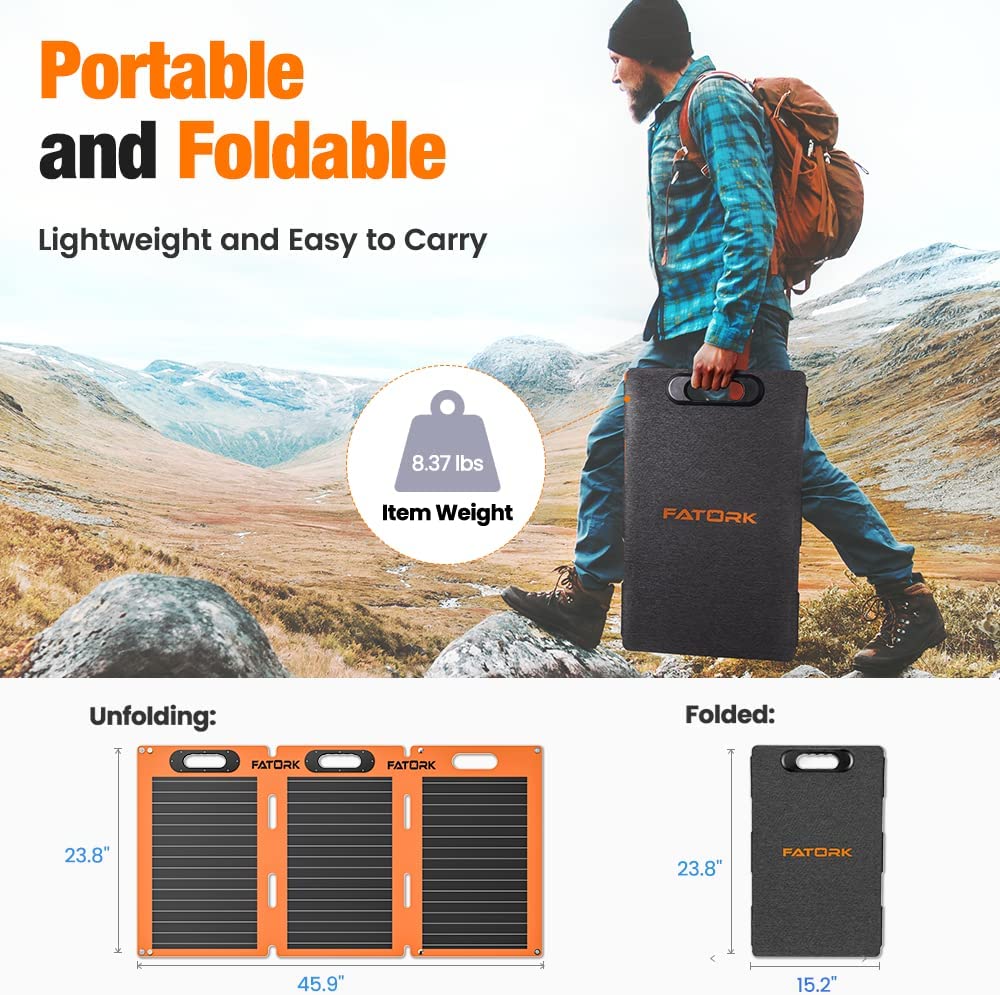
Product specifications
- Peak Power: 100w
- Conversion Efficiency: Up to 24%
- Dimensions (folded): 23.8×15.2×1.1 inches
- Dimensions (unfolded): 23.8×45.9×0.16 inches
- Weight: 8.37 Pounds
- Connectors: XT60 / Anderson / DC7909
The Good
- Compatible with multiple power stations
- Affordable
- Convenient and portable
The Bad
- Limited weather resistance
- Modest power output
This lightweight and portable three-panel solar kit from Fatork boasts a 100w output and three connectors, XT60, DC7909, and Anderson. These output cords make the kit compatible with the majority of portable power stations including, Bluetti, EF Ecoflow, Jackery, and more.
Fatork uses monocrystalline silicon panels for high conversion efficiency, so you get good, consistent power even in low-levels of sunlight.
A built-in carry handle in the high-visibility panel surround makes it easy to transport the panels, and you can find them even in the dark. Magnetic clips hold the panels securely in place when folded, and two kickstands help you position the panels exactly where you need them. A zip-up carrying bag stores the panels and power cords for safe transport.
The panels are IP67 waterproof and durable thanks to a scratch-resistant, heat-resistant, and chemical-resistant ETFE coating. You can leave these panels in light rain but should put them inside if the rain is heavy or if they are sitting in water.
The panels operate at 24% conversion efficiency.
2. Best High-Output Solar Kit: RICH SOLAR 800 Watt 12V Solar kit
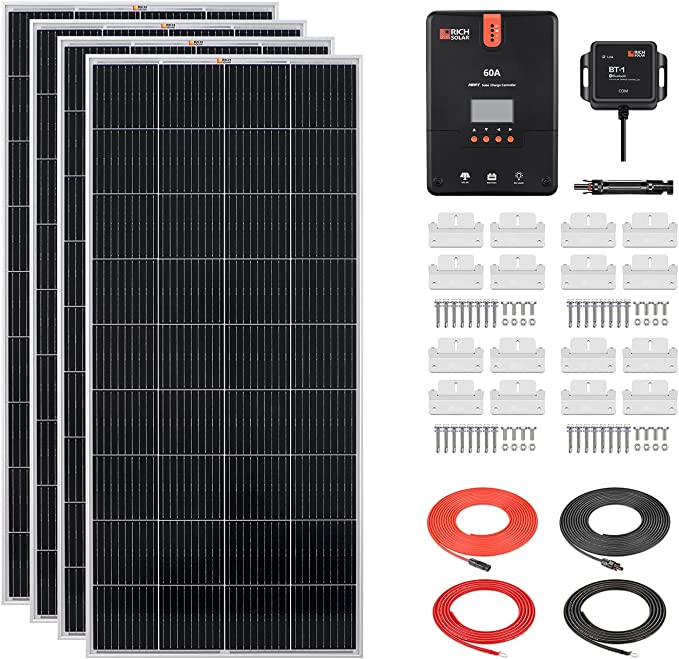
Product specifications
- Peak Power: 800w
- Conversion Efficiency: Not listed
- Dimensions (single panel): 58.7 x 26.8 x 1.4 inches
- Dimensions (four panels): 238.4 x 107.2 x 1.4 inches
- Weight: 26.5 Pounds
- Connectors: XT60
The Good
- Excellent power output
- High-end charge controller
- Easy to set up
The Bad
- Large surface area
- Simple and cheap connectors
Four of RICH Solar’s high-efficiency 200W monocrystalline panels combine in one solar power system designed for tiny homes with big power needs.
The 60A maximum power output tracker (MPPT) controller combined with nine busbars to distribute electricity inside the panels help ensure maximum efficiency and output at all times. Inline fuses help protect the panels, the controller, and your devices from electrical spikes adding extra security.
The MPPT charge controller is also Bluetooth enabled for ease of use. This high-power solar system is ideal for long-term off-grid living and can be pared with large power stations for reliable and consistent energy supply.
RICH Solar systems are plug-and-play with no crimping tools required, so it’s easy to set up and break down the system to head out on the road, and it’s easy for anyone to do.
This solar system kit is supported by a 25-year output warranty.
3. Best Briefcase-Style Solar Panel Kit: Renogy 200 Watt 12 Volt Portable Solar Panel with Waterproof 20A Charge Controller
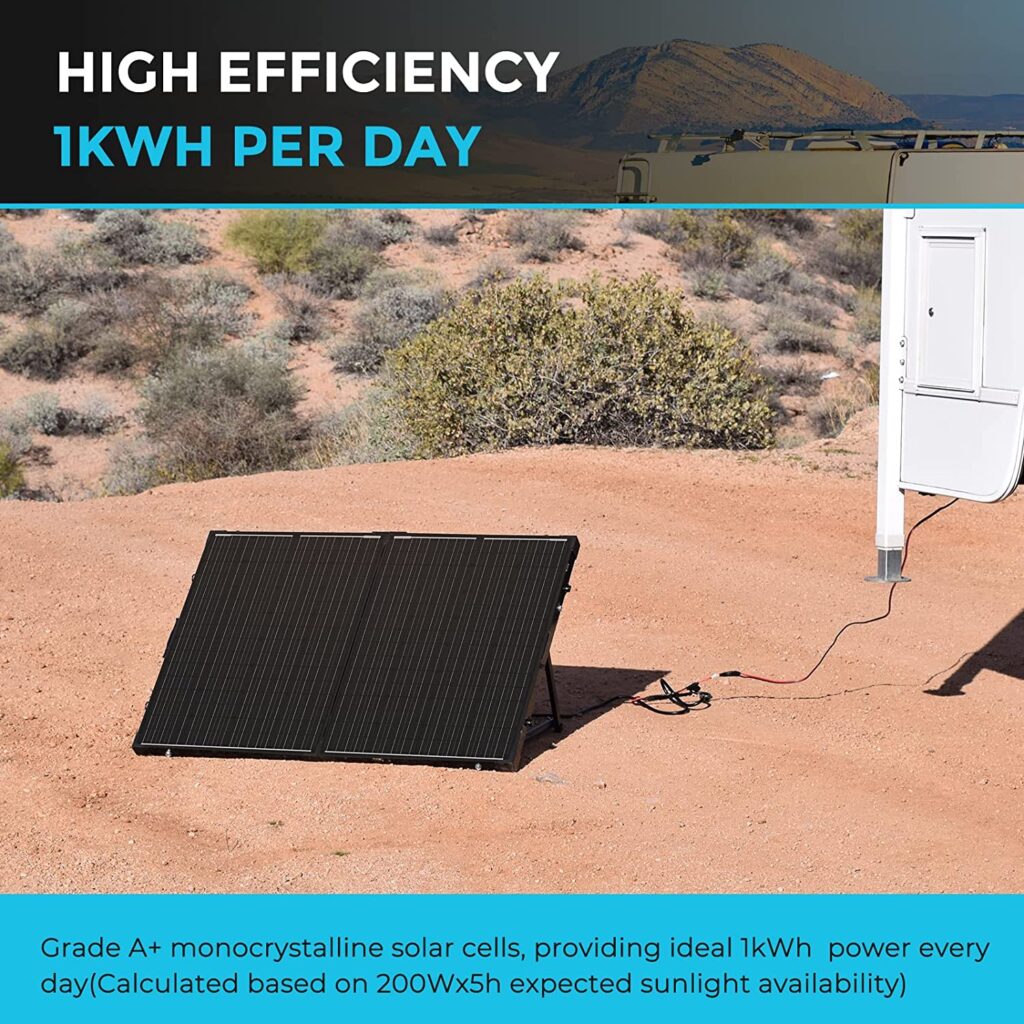
Product specifications
- Peak Power: 200w
- Conversion Efficiency: 21%
- Dimensions (folded): 35.6 x 25.9 x 3.1 inches
- Dimensions (unfolded): 51.8 x 25.9 x 1.55 inches
- Weight: 36 Pounds
- Connectors: MC4
The Good
- Proven brand
- Good efficiency
- Portable and robust
The Bad
- Price for output
- PWM controller isn’t as efficient as MPPT options
Renogy is one of the more proven names around when it comes to renewable energy systems for tiny homes, campers, or RVs. The company’s 200W 12-volt solar panel kit with a 20A charge controller is well-sized for most tiny home dwellers.
You will pay slightly more for Renogy systems than others you find, but the connectors, charge controllers, and the panels themselves are all of high quality. This system combines two monocrystalline panels in a briefcase-style folding unit with a built-in stand.
It’s interesting that Renogy pairs this system with its pulse-width modulation charge controller (PWM). PWM controllers aren’t as efficient as MPPT options, and Renogy does make both. It’s possible Renogy opted for PWM here because it’s safer, and allows this kit to have four charging modes with different levels of protection. That way you can protect your battery bank by offering up a slow charge to start, then a boost to bulk charge, before maintaining a floating charge or equalization charge. This is the safest way to charge and keeps your batteries lasting longer.
Of course if you prefer to, you can just change out the controller for one of Renogy’s MPPT options later to get more efficient charing. This entire set up is expandable for more power, and you can build on it as you go.
The energy panels will produce reliable electricity from the sun for 25 years and Renogy also offers a three-year warranty on workmanship and materials.
4. Best Solar Kit for DC Batteries: Grape Solar 100-Watt Off-Grid Solar Panel Kit
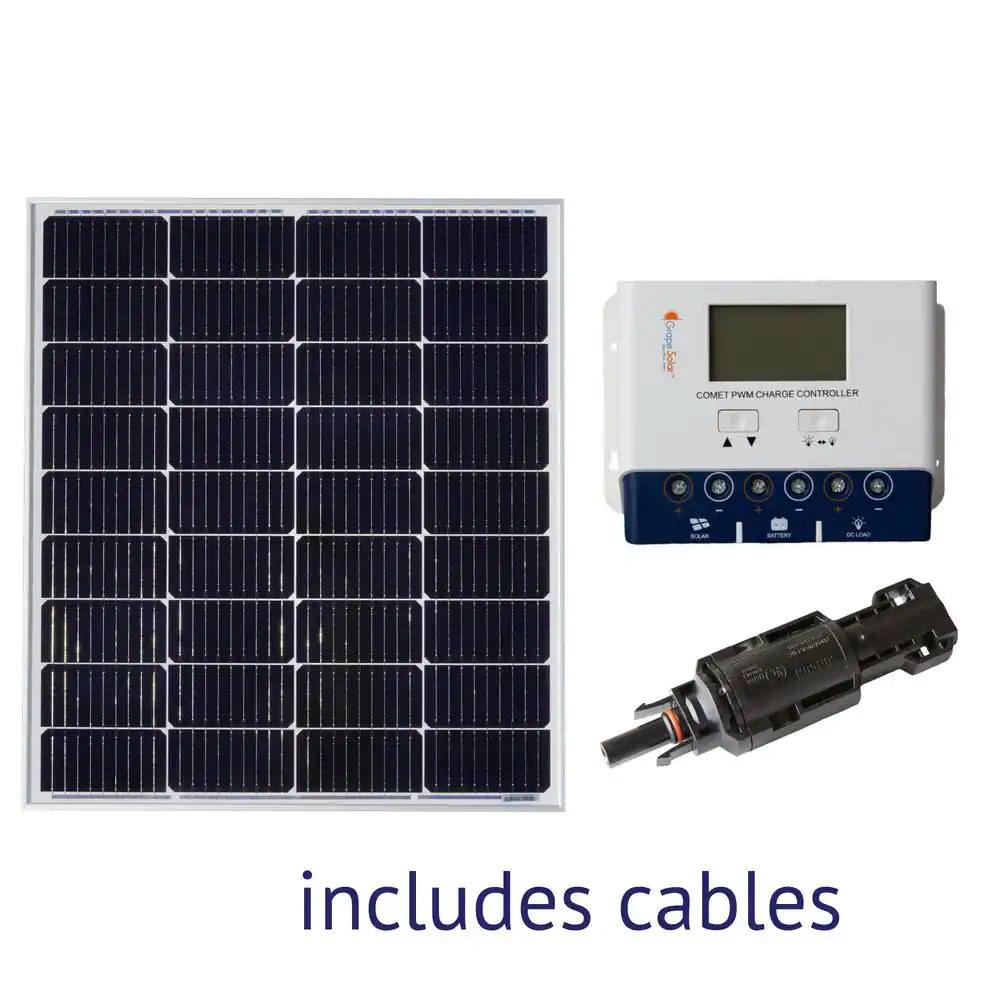
Product specifications
- Peak Power: 100w
- Conversion Efficiency: Up to 24%
- Dimensions (single panel): 31.89 x 28.15 x 1.38 inches
- Dimensions (unfolded): Not applicable
- Weight: 15.4 Pounds
- Connectors: MC4
The Good
- Excellent power output
- High-end charge controller
- Easy to set up
The Bad
- Large surface area
- Simple and cheap connectors
The Grape Solar kit is a simple, small solar charging kit ideal for a true, goal-zero off-grid system. If all you want to do is charge a few small devices or charge a small power station in your tiny home this 100w off-grid solar kit is a solid idea.
It’s best suited for circuits with a 12v deep-cycle battery (or many) which makes it good for RVs and boats as well as tiny homes. You can pair a 12v deep-cycle battery with an inverter for higher voltage appliances.
With one anodized aluminum frame measuring approximately 32×28 inches this isn’t a small panel. On the plus side it is weatherproof and comes with a sealed junction box so you can leave it outside in any weather. A 40A charge controller helps keep the charge consistent, and you can expect about 300 Watt Hours of charge per day from this system.
You can easily add more Grape Solar panels to your system to increase capacity and gain more energy from the system.
5. Best Solar Panel For Rugged Country: EF Ecoflow Adjustable Kickstand Solar Power Kit
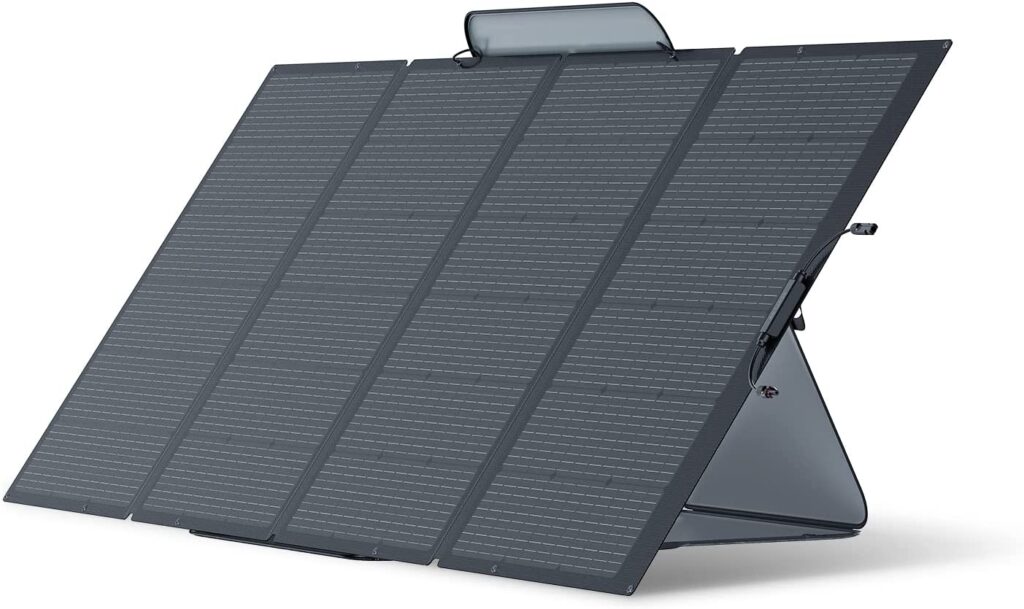
Product specifications
- Peak Power: 400w
- Conversion Efficiency: Up to 22.4%
- Dimensions (folded): 23.2 x 20.2 x 0.8 inches
- Dimensions (unfolded): 41.7 x 93.1 x 1.0 inches
- Weight: 34.2 Pounds (with case)
- Connectors: MC4
The Good
- Rugged built quality
- Solid output
- Portable
The Bad
- No charge controller
- Price
EF Ecoflow’s medium-high capacity solar kit is a four-panel, 400W off-grid energy system that can help you keep your tiny home powered up reliably in most conditions.
Flexible EVA and fibreglass framing make this foldable four-panel system easy to move and pack away, while keeping it robust enough to stand off-road adventures. The Monocrystalline cells are coated in ETFE film which helps keep them safe and scratch-free. The solar kIt also boasts a IP68 Waterproof rating which not only means it’s water tight but will keep dust out of sensitive components.
A set of MC4 connectors make it easy to connect this system to most off-the-shelf powerstations as well as the fleet of stations offered by EF Ecoflow in its Delta, Delta Max, and Delta pro iterations.
The panels come in a dual-purpose carrying case which also operates as a kickstand for the panels when you set them up. Locking tabs keep the panels aligned when they’re unfolded.
The EF Ecoflow solar panel system is among the pricier options because of the build quality. The system also doesn’t come with a charge controller, so you’ll have to pick one up separately.
FAQs About Solar Kits
As a homeowner, the amount of solar panels you need will depend on your energy requirements. For a true off-grid experience you might only need 100W panels, with 800W solar panel systems handling the needs of most modestly equipped tiny home. The good news is you can always build on your solar system to use more renewable energy as your needs and budget grow.
Electricity from the sun into your devices inside your tiny home is both simple and complicated.
In simple terms your solar installation requires:
– A device to capture energy
– A way to control that energy
– A way to store that energy
– A way to convert that energy into usable energy for your devices
Usually, this is done by the following:
Your solar panel “collects” the sun’s energy and converts it to electricity.
The charge controller, which makes sure the energy coming in from the solar panels is controlled properly and doesn’t overcharge your battery bank, power station.
Your solar battery bank or power station is how you store that electricity for future use.
Inverters convert DC electricity from your panels into AC electricity to use your devices. They usually come with 110v household-style outputs and even USB outputs you can plug into. Some power stations double as an inverter, so you don’t need a separate device.
These systems combine together to create a solar generator that can power any number of devices.
A 400W solar power system will run a laptop computer, a television, and even gaming consoles. It’ll also run small fans, and small condenser-style coolers as well.
A 100W solar panel kit is usually enough to charge small devices like phones and tablets, power some lighting, and charge a small power station or battery bank. Because it’s a modest amount of power, you should look for ways to conserve energy like using LED lights instead of conventional bulbs.
Most solar panel kits for tiny homes operate on a 12v system, while some step up to either 24v, 48v or higher. The important part is the charge controller, and how it sends electricity into your energy storage system.
You should look for a power bank or station that is matched with your solar panel setup, but remember, the first question is: How much energy do I need? This is usually calculated in watt hours.
Watt hours are the wattage a device uses over one hour. You can use this figure to determine what size battery and solar panel kit you need.
For example, a 50w light bulb uses about 50w an hour. If you have a lightbulb and a 100w laptop, than you’re using 150w per hour that they’re on. Let’s say both are on for 12 hours a day, you will use 1800 watts per day, or 1.8 kilowatts. A power station and battery bank capable of storing a little more than that should keep you with enough power if you use a 300w solar panel kit to charge the system.